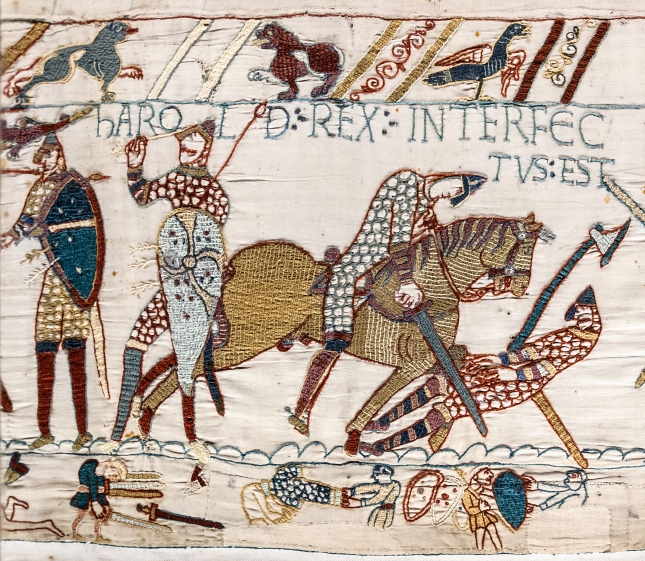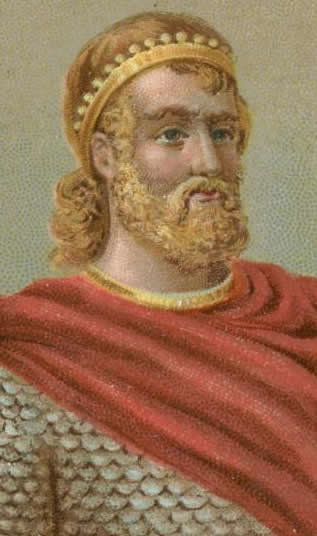
Harold Godwinson doesn’t appear to have had much time for immigrants. To be fair to Harold the class of foreigners he didn’t like crossing his frontiers were not political refugees or fruit pickers, they were after his kingdom. Harold was an Anglo-Saxon. The inevitable merger of Angles and Saxons had taken place a few generations prior. It helped forestall hostile takeover attempts from restless Viking and French invaders. I don’t want to give away the ending too early but Harold was, as it turned out, the last Anglo-Saxon King of England. He was already Earl of Wessex when he was crowned King just under a millennium or so ago this week. The coronation took place in Westminster Abbey on the feast of the Epiphany. Just as I didn’t want to give away the ending I don’t want to mix metaphors, but the crown was a poisoned chalice. Harold was about to have a couple of epiphanies of his own.
He was a descendant of the infamous King Canute, or Cnut, to give him his proper name. Cnut was the English king who sat in a deckchair on the beach and commanded the waves to go away, and the tide to stay out. This bizarre behaviour has been culpably misunderstood ever since. Cnut was nobody’s fool – he didn’t imagine the moon was going to take the day off and neglect its gravitational duties. In fact he didn’t even know the moon was in control of proceedings. What he did know was that the waves would continue to flow inexorably, and that he would get his feet wet. He was actually attempting to demonstrate the limits of kingly power, rather than that he was an idiotic megalomaniac who thought he had power over the tides. Glad we could clear up that bit of fake history in passing!
Back to Harold. Now he should probably have taken his ancestor’s lesson in realpolitikto heart. That’s because he wasn’t in a position to learn from the mistakes of Napoleon and Hitler, of fighting a war on two fronts. It was 1066 and all that, and Hitler and Napoleon would not be around for hundreds of years.

Instead Harold took on the Viking invaders of his kingdom, led by a rival claimant to his throne who, in an effort to sow confusion, was also called Harold. Harold Hardrada of Norway invaded England in September 1066. Harold Godwinson of Wessex took his army north and defeated the Viking invaders at the Battle of Stamford Bridge. For the record Stamford Bridge was actually a village in the East Riding of Yorkshire long before it became a football stadium in London dependent on the largesse of a Russian oligarch.
Having beaten the Vikings, Harold might have thought he could relax a little and start to enjoy his reign as King of England. No such luck. Another rival claimant to his throne emerged from the far side of the English Channel in Normandy. At least this one was called William, not Harold, thus making it easier to tell the two competing Kings apart. Harold was forced to march his army more than 240 miles south to the Sussex village of Hastings.
So, it’s 1066 and Harold is about to fight the Battle of Hastings. You probably know what’s coming next. The army of William of Normandy wins the battle and Harold is killed.
But the question is, was he killed by an enterprising archer who fired an arrow into his eye. This is how the famous Bayeux tapestry depicts his demise. A Norman account of the battle suggests that Harold was surrounded by four of their knights, was killed, and had his body dismembered. The fact that one of the four knights was supposed to be Duke William of Normandy himself suggests that this is a piece of ex post factopropaganda designed to make Norman Bill look like a regicidal superman. Other contemporary accounts suggest that Harold was killed by an arrow to the head, but that it did not enter via his eye socket. The ‘arrow in the eye’ narrative emerges a couple of decades after the battle and was just too good for the embroiderers of the Bayeux Tapestry to ignore.
When you think of the Tapestry the image that immediately comes to mind, after Halley’s comet, is that of an Anglo Saxon knight with an arrow in the head under the legend ‘Harold Rex interfectus est’, or ‘King Harold is killed’, in the vernacular. The problem is that there are at least four knights in the vicinity, so there is no guarantee that the one with the arrow in his head is actually Harold. But, on the balance of probability, that must be the case. The Tapestry would have been created around the time thatversion of Harold’s death was gaining currency. But that doesn’t mean it’s accurate.
So, was Harold of Wessex killed by an archer who managed to pierce his eye with an arrow? A Scottish verdict would be wise in this case, not proven. It may, or may not, be fake history.

You must be logged in to post a comment.